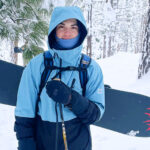Ready for the next step: Innovative care for Chase

Chase Essex loves pizza and has even prepared shrimp scampi for his family. So it might come as a surprise that, until recently, the 14-year-old hadn’t eaten by mouth for much of his life. “Now,” says his mother, Antoinette, “he eats everything in sight.”
More than a decade ago, Chase was like any other curious little kid when he entered his family’s closed upstairs bathroom to brush his teeth. He moved a covering from the sink, briefly dipped his toothbrush into what he believed was water and touched it to his mouth. But the small puddle of liquid at the bottom of the sink wasn’t water. It was lye-based drain cleaner, which his parents had poured into the drain in an effort to unclog it. In an instant, life changed for the Essex family.

Reaching a standstill
Lye is a corrosive substance, and even the tiny amount that Chase swallowed left his esophagus and trachea severely damaged. After being treated at the emergency room, he was airlifted to a children’s hospital in nearby Washington, DC, for more extensive care. There, he underwent a tracheostomy, which allowed him to breathe through a surgically created hole in his neck.
Over the next several years, Chase had nearly three dozen other procedures, most of them aimed at addressing the damage to his trachea. The care he received was good, but Chase, Antoinette and his father, Craig, eventually found that his progress had reached a standstill.
“Ultimately, we realized that Chase’s doctors just didn’t know the next step — they didn’t believe the damage to his esophagus could be reversed,” says Antoinette. Recommendations and research led the Essexes to the Esophageal and Airway Treatment (EAT) Center at Boston Children’s Hospital in 2016.

Encouraging progress
The family quickly discovered that they had made the right decision for Chase. “When we first called and spoke with the clinical coordinator, Dori Gallagher, she wasn’t fazed at all by Chase’s condition,” remembers Antoinette. “That was very encouraging.”
They were further encouraged upon meeting the clinicians in person. Chase’s care team includes EAT’s surgical director, Dr. Russell Jennings and its medical director, Dr. Michael Manfredi, as well as Dr. Reza Rahbar, director of the Center for Airway Disorders. To ensure that the challenging case had the best chances of success, they consulted with Dr. Amir Taghinia and Dr. Brian Labow of the Department of Plastic and Oral Surgery, who recommended a staged approach that would culminate in a jejunal interposition. In this procedure, surgeons replace the missing section of a child’s esophagus with a section of the jejunum (the middle part of the small intestine). It’s a sophisticated technique that these Boston Children’s surgeons have perfected.
“We were comfortable with this plan because we trusted the team’s skills and experience,” explains Antoinette. “They told us that this approach had the potential to let Chase eat and swallow again.”

Learning to swallow again
In August 2017, Drs. Taghinia and Labow took Chase to the operating room for the first stage of his reconstruction, which involved releasing some of the scarred tissues above his airway and creating a temporary skin tube from his thigh to replace the upper part of his esophagus. This temporary tube drained out of Chase’s neck, allowing him to practice drinking and preventing him from having to spit out his saliva as he had always done before. In May 2018, Chase underwent the second stage of his reconstruction with a 17.5-hour procedure, which was a success.
As he recovered in the hospital, he felt both excited and a little hesitant. Over the years, his parents had tried to prevent food aversions by letting him practice tasting lollipops and other treats. But swallowing was different. “I knew he might lose muscle memory, and it’s nearly impossible to teach someone to swallow if they’ve never done it,” says his mother.
Indeed, Chase couldn’t remember what swallowing felt like — without a functional esophagus, he had always spit out food and saliva. Now, he was scared to try. But when he finally did, there was no stopping him. “He told us he wanted tomato soup and SpaghettiOs as his first meal,” laughs Antoinette. “He’d never had those before his accident and we have no idea why he chose them now.” The verdict: He’s a fan of tomato soup but prefers real pasta dishes over the canned stuff.

Like family
For now, Chase still relies on a feeding tube for some of his nutrition — “He’s naturally thin and really active, so it’s hard for him to keep weight on,” says Antoinette. When he’s not cooking for himself and his parents, the teen can be found playing soccer, practicing his ukulele or performing traditional Polynesian dance.
The family recently returned to Boston for a checkup, before Dr. Rahbar and his colleagues began the process of planning a repair of Chase’s airway that may allow him to breathe without the tracheostomy. While in town, they stayed at the Yawkey Family Inn, which provides affordable accommodations to Boston Children’s patients and their families. “We love seeing the staff there,” says Antoinette. “We think of them like family, just like Chase’s doctors and nurses.” And pizza was most definitely on the menu.
Learn about the Esophageal and Airway Treatment (EAT) Center and the Department of Plastic and Oral Surgery. Read more about the innovative staged approach taken by Drs. Labow and Taghinia here.
Related Posts :
-

Understanding and treating Mason’s congenital nevus
Kim and Ryan noticed their son’s birthmark almost immediately after he was born. They knew birthmarks were common, but ...
-

Using her voice: After tracheomalacia treatment, Claire keeps her eye on the ball
Claire Kantany is only 10, but she knows what she wants to do when she grows up — in fact, she’...
-

Pirate puzzles and peekaboo: Beckett’s brachial plexus birth injury story
Beckett Stone-Lyman is an adorable, fun 2-year-old who loves to run, sprint, and climb. If he’s not charging around ...
-

Griffin’s return to the slopes and sea after kneecap dislocation
Whether cruising down a snowy trail or catching a wave, 18-year-old Griffin Srokose loves the adrenaline and freedom he feels ...





